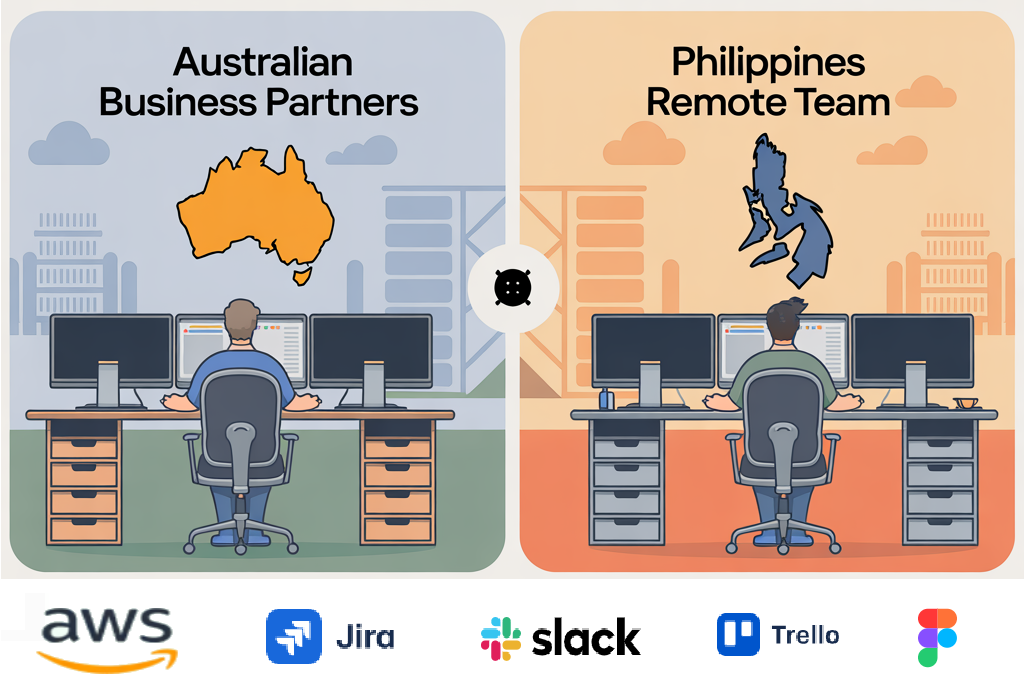Looking to grow your business without blowing your budget? Outsourcing to the Philippines might just be the smartest move you make. But how do you choose the right outsourcing partner in the Philippines?
With hundreds of providers claiming to offer the best outsourcing services, it’s easy to feel overwhelmed. In this guide, we’ll walk you through what to look for, what to avoid, and how to make the most out of your outsourcing partnership.
Topic Breakdown
Why Outsourcing to the Philippines Works for Aussie Businesses
Australia and the Philippines have built a strong outsourcing relationship, and for good reason. Here’s why more Aussie businesses are turning to Filipino talent to support their growth.
- Cultural compatibility: Strong English skills and Western-aligned work culture
- Time zone advantage: Perfect for extended or 24/7 business hours
- Cost savings: Save up to 70% on salaries without compromising output
- Skilled talent pool: Access experts in IT, design, customer service, and admin
Step-by-Step: How to Find the Right Outsourcing Partner in the Philippines
Not all outsourcing companies are created equal. Use this step-by-step guide to confidently choose a reliable outsourcing partner that fits your goals.
1. Define Your Business Needs
Before you start searching, it’s important to clarify what you want to outsource and why. This step helps narrow down your options and ensures you’re clear on what success looks like. So before you Google “best outsourcing company in the Philippines“, pause and ask:
- What tasks do I need help with?
- Do I need full-time staff or project-based help?
- What KPIs matter most?
Tip: Start with 1-2 roles to try out the partnership.
2. Check the Company’s Track Record
Experience counts. A strong outsourcing partner will have proof of success, long-term clients, and a reliable system for delivering results. They should:
- Have verified case studies and client reviews
- Be responsive and transparent
- Offer a dedicated account manager
👀 Look for companies with long-term Aussie clients. It signals trust and reliability.

3. Ensure Proper Infrastructure & Tools
Technology and systems can make or break your outsourcing experience. Make sure your offshore partner uses tools and processes that support smooth, secure collaboration. Ask them these questions:
- Do you provide secure remote work setups?
- What tools do your teams use for project management and communication?
- How do you ensure data privacy?
You’re not just picking an outsourcing partner—you’re selecting someone who can integrate smoothly into your operations.
4. Evaluate Communication and Support
Clear communication is essential when working across borders. How your outsourcing partner engages with you early on will often reflect how the relationship will play out. Clear, prompt communication is non-negotiable.
- Test responsiveness via email or chat
- Ask about regular check-ins (daily, weekly, bi-weekly, or monthly, depending on your needs or preference)
- Check if their team is trained for client-facing roles
💡 Pro tip: A great outsourcing company in the Philippines will treat your goals as their own.
5. Start With a Trial Period
Don’t jump into long contracts. A trial run lets both parties assess the fit without long-term pressure. This phase is key to testing quality, collaboration, and team dynamics. A 30- to 90-day trial allows both sides to test:
- Quality of work
- Work ethic and culture fit
- Turnaround times
Red Flags to Watch Out For
Not every outsourcing company delivers what they promise. Be aware of these warning signs before signing any contracts:
- 🚩 Unclear pricing or hidden fees
- 🚩 No client references
- 🚩 Poor communication or pushy sales tactics
- 🚩 Vague service offerings
If it feels too good to be true, it probably is.
📖 RELATED READING: Warning: 10 Critical Red Flags in Outsourcing Tech Development You Need To Know
What Sets the Best Outsourcing Services Apart
There’s a big difference between average and exceptional providers. Top-tier providers don’t just fill roles. Here’s what to look for if you want real value from your outsourcing investment:
- Talent matching based on your work style
- Onboarding assistance
- Scalable support (from 1 to 100 staff)
- Transparent pricing with clear deliverables

Recap: Checklist to Find the Right Partner
To wrap things up, here’s a quick checklist to help you stay focused as you choose your outsourcing company in the Philippines.
- ✅ Know what tasks you want to outsource
- ✅ Check company reviews and case studies
- ✅ Confirm infrastructure and tools
- ✅ Test communication early
- ✅ Trial before signing a long-term deal
🧠 Reminder: The right partner can help you scale smarter, not just cheaper.
FAQs
What should I look for in an outsourcing company in the Philippines?
Look for verified experience, clear communication, transparent pricing, and tools that align with your business processes.
Is outsourcing to the Philippines good for small Australian businesses?
Yes, outsourcing offers cost savings, access to skilled talent, and flexible support, making it ideal for startups and SMEs.
How much does it cost to outsource to the Philippines?
Costs vary by role, but you can save up to 70% on labour compared to hiring locally.
How do I ensure data security when outsourcing?
Choose providers that offer secure remote infrastructure, sign NDAs, and comply with data protection regulations.
Conclusion: Choose an Outsourcing Partner That Grows With You
Outsourcing to the Philippines isn’t just about saving costs—it’s about finding the right team to help you grow smarter and faster. Whether you’re a solo founder or running a scaling company, choosing the right outsourcing partner in the Philippines can give you the edge to compete, adapt, and expand in today’s fast-moving market.
Connect with a trusted outsourcing company in the Philippines that understands how Aussie businesses work. Take your time to vet providers, start small, and look for long-term alignment. The best outsourcing companies aren’t just service providers but partners in your success.
Ready to explore your outsourcing options?